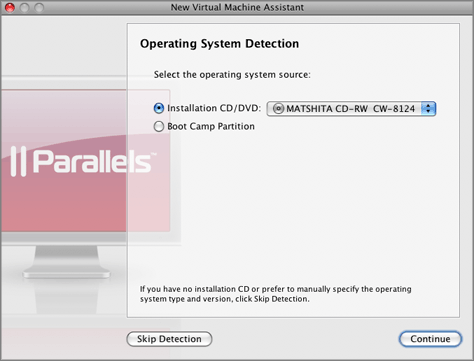Express Linux Mode
Before creating a virtual machine in the Express Linux mode, make sure that you have an operating system installation disc or its image.
Note: Parallels Desktop doesn't provide you with the operating system installation discs and their images. You should purchase or get anyhow the Linux installation disk or its image if you do not have any.
To start New Virtual Machine Assistant, click the
New
button
![]() in the
Parallels Virtual Machines
list.
in the
Parallels Virtual Machines
list.
To create a new virtual machine:
-
Parallels Desktop will try to automatically determine the type and version of your operating system. In the
Operating System Detection
window, select the
Installation CD/DVD
option, specify the source of installation files, and click
Continue
. You can specify the following types of installation media:
- A real CD/DVD drive. Click the Installation CD/DVD field, and select the real CD/DVD drive name from the list if you inserted the installation disc into the optical drive of your Mac. Click Continue , and go to Step 6.
-
A CD/DVD image file. Click the
Installation CD/DVD
field, and select the installation disc image from the list, or click
Choose an image file
, and locate the file on your Mac. Click
Continue
, and go to Step 6.
Note: Parallels Desktop supports the following types of image files: ISO, CUE, CCD, and DMG.
You can provide the OS installation disk later after the virtual machine creation. In this case, click Skip Detection , and go to the next step.
If you have the Boot Camp partition in your Mac and select the Boot Camp Partition option in this window, the assistant will proceed with the Boot Camp virtual machine creation. For detailed information, see Creating a Virtual Machine for the Boot Camp Partition .

- If you clicked Skip Detection on the previous step, select the type and version of the operating system you would like to install in the virtual machine in the Select Operating System Type and Version window. To proceed with the Express Linux mode, select the Linux type and version. In the Express Linux mode, the following versions are supported: Ubuntu Linux, Fedora Linux, Fedora Core 5 Linux, and Red Hat Enterprise Linux. When finished, click Continue .
- In the Virtual Machine Type window, select the Express Linux mode.
-
In the
Express Linux Installation
window, specify the information necessary for the Linux guest OS installation.

If you click the Advanced button, you can set the number of CPUs and the amount of RAM of your future virtual machine. Click Continue .
-
If you have not provided the guest operating system installation files on the second step of the assistant, the
Insert the installation CD ...
window will appear. In this window you should provide the guest operating system installation files. You can specify the following types of installation media:
- A real CD/DVD drive. Click the CD/DVD field, and select the real CD/DVD drive name from the list if you inserted the installation disc into the optical drive of your Mac.
- A CD/DVD image file. Click the CD/DVD field, and select the installation disc image from the list, or click Choose an image file , and locate the file on your Mac.
-
In the next step, you should define the main parameters for your virtual machine:
- Name . Indicate the name to be assigned to the virtual machine. By default, the virtual machine gets the name of the operating system that you selected to be installed in this virtual machine. If a virtual machine with this name already exists, you will be prompted to specify another name. The name must not exceed 50 characters.
-
Let other Mac users access this virtual machine.
Select this option if you want to share this virtual machine with other users of your Mac. In this case the virtual machine file (PVM file) will be saved in the /
Users/Sharedfolder on your Mac. - Location . In this field, specify the virtual machine files location.
If you click the Advanced button, you can set the number of CPUs and the amount of RAM of your future virtual machine.

When finished, click Create . The assistant will create a blank virtual machine.
-
In the
Boot Options
section of the
Prepare to Install Operating System
window, you can change the OS installation files source if you want.

When finished, click Start . New Virtual Machine Assistant will install the guest operating system in your new virtual machine. When the installation is complete, install Parallels Tools if they are available for the guest OS you just installed.
Note: If your copy of Parallels Desktop is not activated, you will be prompted to activate it when you click Start . For more information about the activation, see Activating Parallels Desktop .
The newly created virtual machine will be accessible through Parallels Virtual Machine List that allows you to easily manage your virtual machines.
|
|
 Feedback
Feedback
|